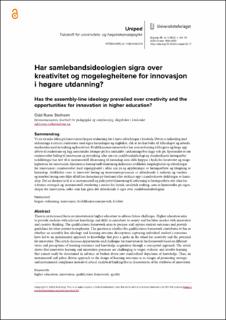| dc.contributor.author | Stalheim, Odd Rune | |
| dc.date.accessioned | 2022-07-29T13:24:39Z | |
| dc.date.available | 2022-07-29T13:24:39Z | |
| dc.date.created | 2022-04-05T08:55:07Z | |
| dc.date.issued | 2022 | |
| dc.identifier.citation | UNIPED. 2022, 45 (1), 64-74. | en_US |
| dc.identifier.issn | 1500-4538 | |
| dc.identifier.uri | https://hdl.handle.net/11250/3009202 | |
| dc.description | Copyright © 2022 Author(s). This is an open access article distributed under the terms of the Creative Commons CC BY 4.0 License (https:// creativecommons.org/licenses/by/4.0/). | en_US |
| dc.description.abstract | Vi ser eit auka fokus på innovasjon i høgare utdanning for å møta utfordringar i framtida. Det er ei målsetjing med utdanninga å utrusta studentane med eigna kunnskapar og dugleikar, slik at dei kan bidra til fellesskapet og arbeidsmarknaden med nytenking og kreativitet. Kvalifikasjonsrammeverket har som målsetjing å klargjera og fanga opp utbyte til studentane og legg samstundes føringar på kva innhaldet i utdanninga bør legga vekt på. Spørsmålet er om rammeverket bidreg til innovasjon og nytenking, eller om ein samlebandsideologi og standardiserte læringsutbyteskildringar har ført til ei instrumentell tilnærming til kunnskap som stikk kjeppar i hjula for kreativitet og mogelegheitene for innovasjon. Gjennom ei konseptuell tilnærming diskuterer artikkelen mogelegheiter og utfordringar for innovasjon i rammeverket med utgangspunkt i ulike syn på og oppfatningar av læringsutbyte og tileigning av kunnskap. Artikkelen viser at innovativ læring og innovasjonsprosessar er utfordrande å målsetja og vurdera og inneber læring som ikkje alltid kan fastsetjast på førehand eller stykkast opp i standardiserte skildringar av kunnskap. Det ser dermed ut til at ei instrumentell og policystyrt tilnærming til utforming av læringsutbyte står i fare for å fremja strategisk og instrumentell etterleving i staden for kritisk, analytisk tenking, som er kjenneteikn på eigenskapar for innovasjon, noko som kan gjera det utfordrande å sigra over samlebandsideologien. | en_US |
| dc.description.abstract | Abstract
There is an increased focus on innovation in higher education to address future challenges. Higher education aims to provide students with relevant knowledge and skills to contribute to society and the labor market with innovative and creative thinking. The qualifications framework aims to prepare and capture student outcomes and provide guidelines for what content to emphasize. The question is whether the qualifications framework contributes to this or whether an assembly line ideology and learning outcome descriptions capturing individual student’s outcomes have led to an instrumental approach to knowledge that puts a spoke in the wheel for creativity and the potential for innovation. This article discusses opportunities and challenges for innovation in the framework based on different views and perceptions of learning outcomes and knowledge acquisition through a conceptual approach. The article shows that innovative learning and innovation processes are challenging to target, evaluate, and involve learning that cannot easily be determined in advance or broken down into standardized depictions of knowledge. Thus, an instrumental and policy-driven approach to the design of learning outcomes is in danger of promoting strategic and instrumental compliance instead of critical, analytical thinking that is characteristic of the attributes of innovation. | en_US |
| dc.language.iso | nno | en_US |
| dc.rights | Navngivelse 4.0 Internasjonal | * |
| dc.rights.uri | http://creativecommons.org/licenses/by/4.0/deed.no | * |
| dc.subject | høgare utdanning | en_US |
| dc.subject | innovasjon | en_US |
| dc.subject | kvalifikasjonsrammeverk | en_US |
| dc.subject | kvalitet | en_US |
| dc.subject | higher education | en_US |
| dc.subject | innovation | en_US |
| dc.subject | qualification framework | en_US |
| dc.subject | quality | en_US |
| dc.title | Har samlebandsideologien sigra over kreativitet og mogelegheitene for innovasjon i høgare utdanning? | en_US |
| dc.title.alternative | Has the assembly-line ideology prevailed over creativity and the opportunities for innovation in higher education? | en_US |
| dc.type | Peer reviewed | en_US |
| dc.type | Journal article | en_US |
| dc.description.version | publishedVersion | en_US |
| dc.subject.nsi | VDP::Samfunnsvitenskap: 200::Pedagogiske fag: 280 | en_US |
| dc.source.pagenumber | 64-74 | en_US |
| dc.source.volume | 45 | en_US |
| dc.source.journal | UNIPED | en_US |
| dc.source.issue | 1 | en_US |
| dc.identifier.doi | https://doi.org/10.18261/uniped.45.1.7 | |
| dc.identifier.cristin | 2015289 | |
| cristin.ispublished | true | |
| cristin.fulltext | original | |
| cristin.qualitycode | 1 | |

